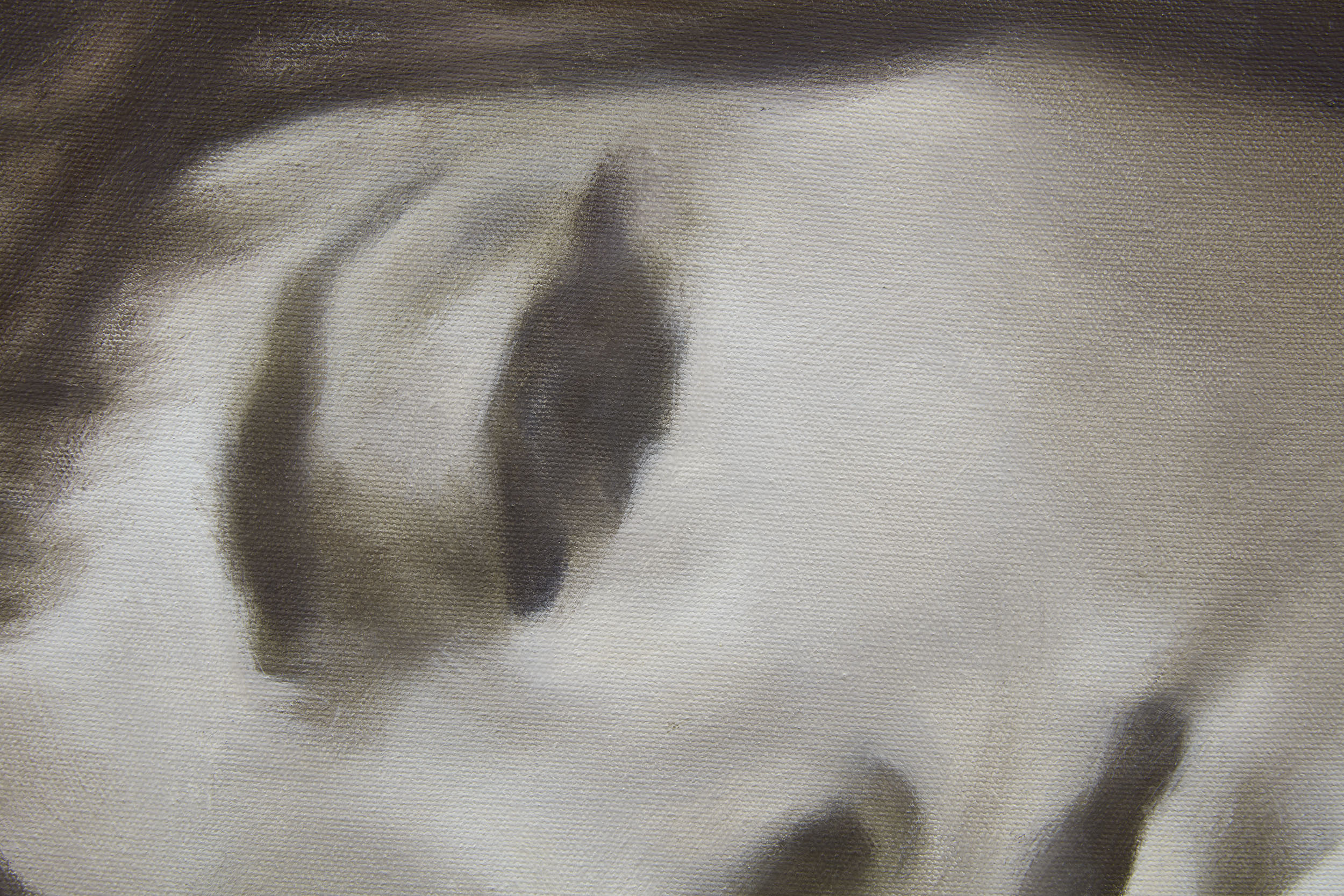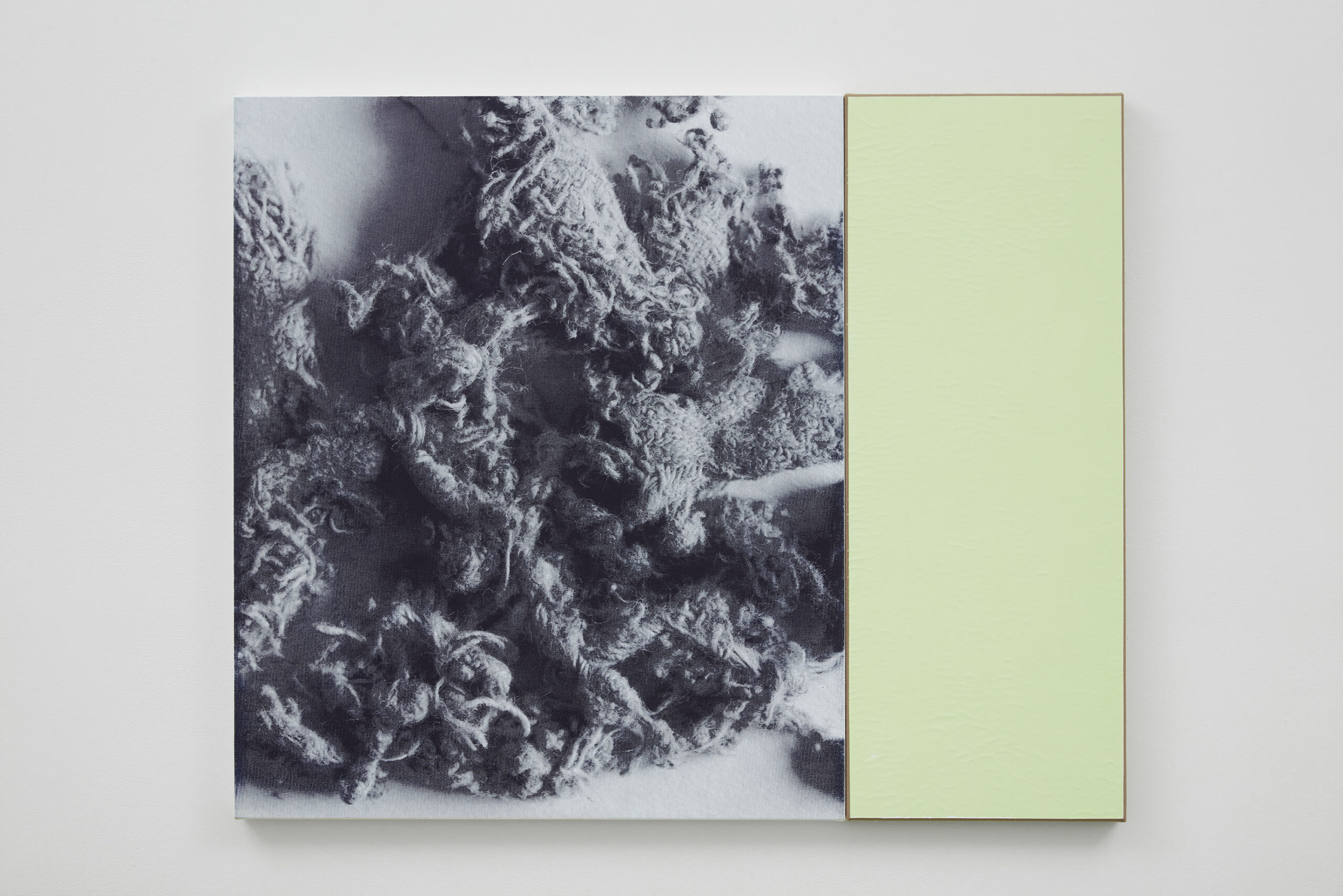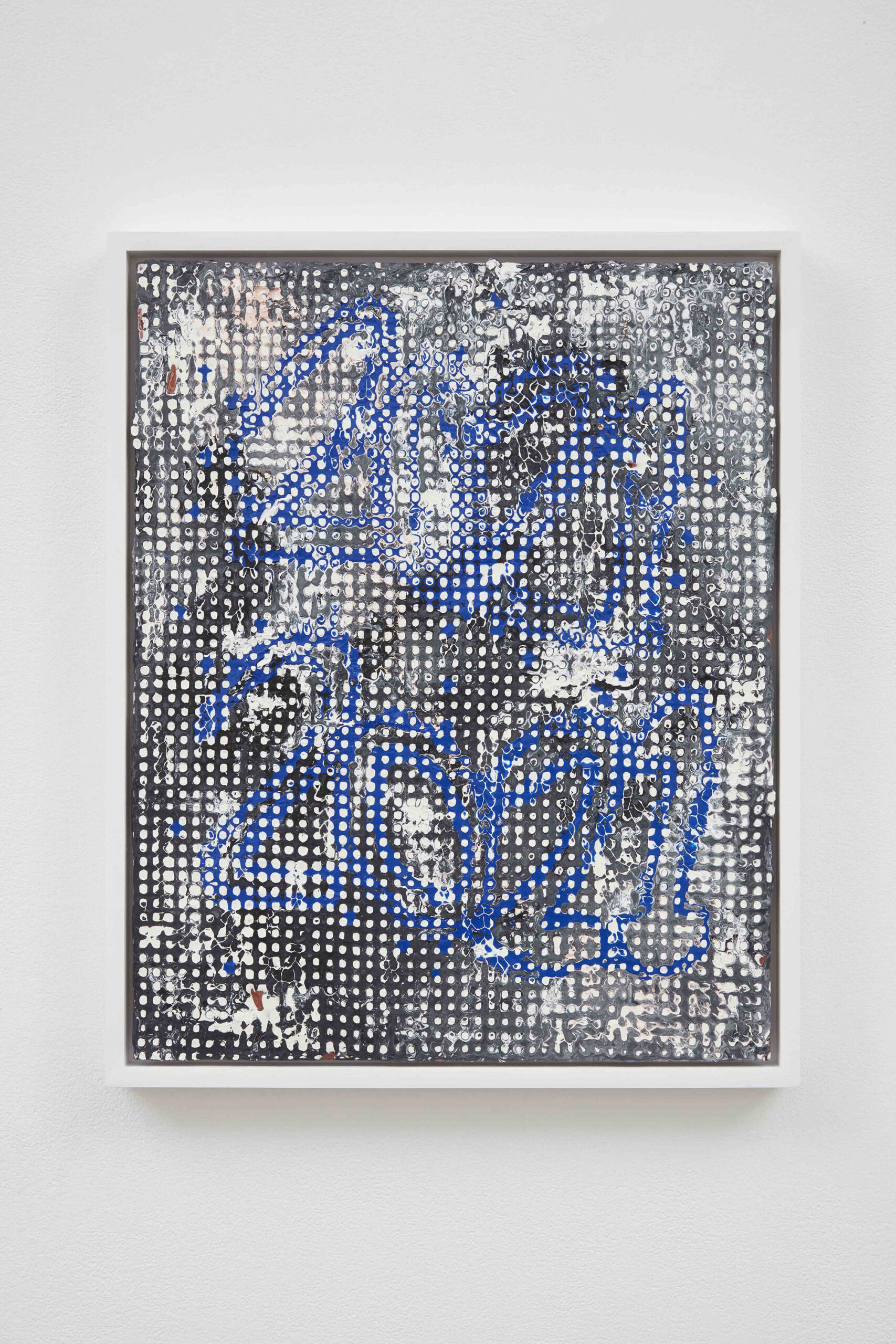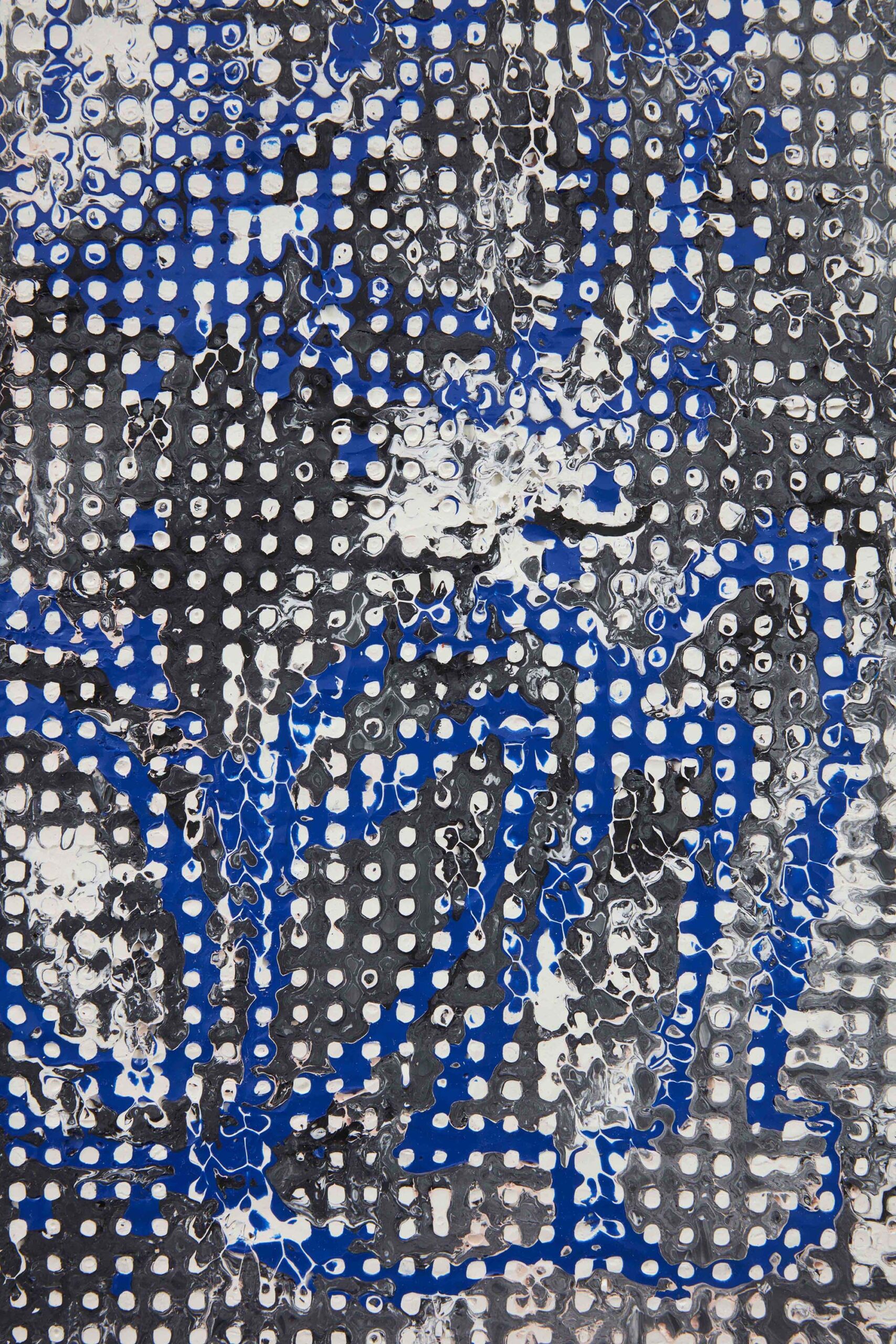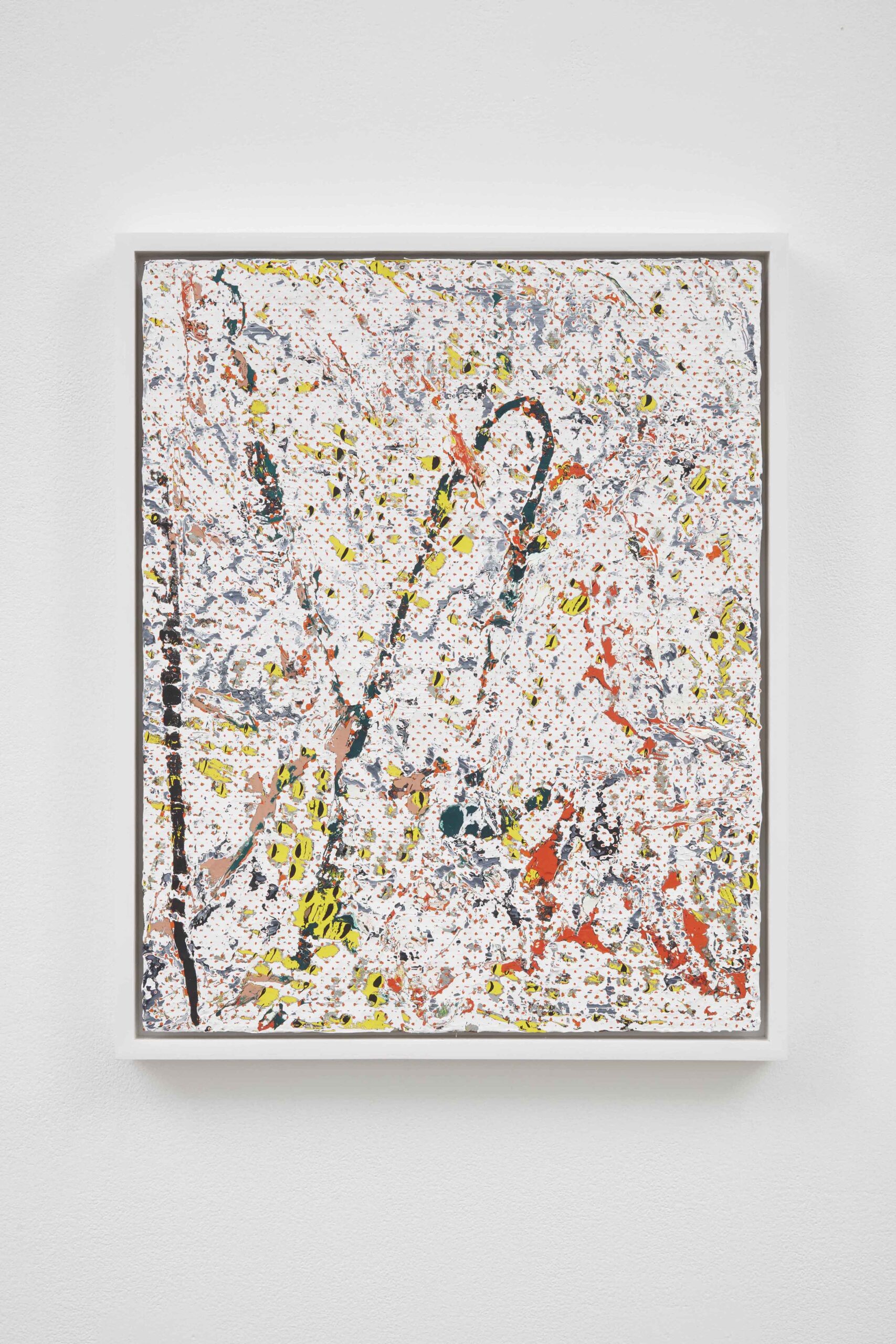![]()
Igshaan Adams
Haar Onvangs Was Koud (her reception was cold), 2021
Wood, painted wood, plastic, glass, stone and bone beads, metal charms
(knives), polyester and nylon rope, chain, wire and cotton twine
81.1 x 62.6” / 206 x 159cm
Igshaan Adams’ (b. 1982, Cape Town, South Africa) multi-disciplinary practice is an ongoing examination of hybrid identity, exploring notions of race, religion, and generational trauma. Adams combines weaving, performance, and installation in an intersection of personal history and his native Cape Town roots. Raised in Bonteheuwel, a former Cape Coloured township in Cape Town created during apartheid, the race-based legislation of the 1950s, Adams reshapes materials representative of his lineage—sourcing rope, cotton, beads, prayer rugs, garden fencing wire, and remnants of linoleum flooring found in the homes of working class, mixed-race and black communities.
Haar Onvangs Was Koud (2021) (translated from Afrikaans to “Her Reception was Cold") is part of Adams’ recent body of heavily embellished weavings inspired by patterns found in the remnants of linoleum flooring removed from the homes of childhood friends and neighbors, and then repurposed in the studio.
Composed entirely of locally sourced materials purchased in Bonteheuwel — wood, plastic, stone, glass and bone beading, metal charms, nylon rope, chains and fringe, along with cotton twine — the tapestries articulate actual spaces.
Relic-like, the extracted ground is a domestic time capsule recording bodily weight. Worn-out motifs reveal the daily movements of the people who live there, shedding history and trauma with each marking. Adams’ own history is housed in these spaces; memories from childhood through adolescence are imprinted upon these fragments that are transformed into handmade woven compositions.
In 2022, Adams will present solo exhibitions at the Art Institute of Chicago, IL and Kunsthalle Zurich, Switzerland.
![]()
![]()
Kevin Beasley
The Beginning of the End, 2021
Polyurethane resin, epoxy resin, raw Virginia cotton, dye-sublimation
printed t-shirts, carbon fiber
84 x 93 x 2” / 213.36 x 236.22 x 5.08cm
Kevin Beasley’s (b. 1985, Lynchburg, VA) series of slabs are comprised primarily of raw cotton harvested near his family’s century-old property in rural Virginia, as well as personal garments set in polyurethane resin. These sculptural forms revert back to antiquity, reflecting on ancient stone relief sculptures, specifically 9th c. BCE Assyrian reliefs which depict battle scenes, religious rituals, and courtly settings in rich detail and highly schematic imagery. Originally conceived in 2017, Beasley’s slabs began as large-scale square and rectangular structures that rested on the floor, flush to the wall with the potential to be rotated. In recent years, Beasley has elevated the slabs, which now hang on the wall, occupying the traditional space of painting.
Unlike Beasley’s previous abstract color fields, The Beginning of the End (2021) prominently features the image of a woven basket printed onto a grid of twelve t-shirts, sourced from a single photograph that Beasley took in 2012 in Maplesville, Alabama at the workshop where he purchased the cotton gin motor that became the focus of his 2018 - 2019 Whitney Museum solo exhibition, A view of a landscape.
The hand-made basket was woven roughly sixty years ago by a farm laborer to aid in the collection of cotton. Now, it is framed in a field of recently harvested Virginia cotton and fossilized in resin. Images and material are interchangeable and reference the same origin. Beasley connects his own familial history with the complex, shared histories of the broader American experience as it relates to the production of cotton and black land ownership in the South.
Beasley’s work is currently on view in The Dirty South: Contemporary Art, Material Culture, and the Sonic Impulse at the Contemporary Art Museum of Houston, as well as Prospect.5 New Orleans: Yesterday We Said Tomorrow at the Contemporary Art Center in New Orleans, LA.
![]()
![]()
Matthew Brannon
Concerning Vietnam: PX Alley 1966, Soap, 2021
Silkscreen with hand-painted elements on paper
Paper: 52 x 67” / 132.08 x 170.18cm
Framed: 56.5 x 71.5” / 143.51 x 181.61cm
Matthew Brannon’s (b. 1971, St. Maries, ID) distinctive visual language, developed through his unique prints, is imbued with wit and history. Employing traditional silkscreen printing techniques with hand-painted elements, the artist layers hundreds of screens within an intricate network of boldly colored, overlapping symbolic objects. As a source of inspiration, Brannon has often delved, through exhaustive research, into the period of the Vietnam/American War.
Concerning Vietnam: PX Alley 1966, Soap (2021) depicts an inventory of household soap and cleaning products, aligned and stacked. This showcase refers to the black market activities within the illegal trade of foreign products in Vietnam during the War years. Seemingly banal goods are instantly identifiable, rendered with crisp logos and product labels in an aesthetic akin to Pop Art’s elevation and criticism of the machine that is mass advertising.
In Brannon’s words —
From the start, I’ve been interested in the suggestive found in the most innocent of items. I grew up amidst the packaged, branded world of consumer products that announced with bold type and exclamation points that all would be fine if I just used them. All wars contain black markets. America’s abundant resources can be seen as the almost unstoppable differentiating force behind the success of allies in World War I & II. In the wake of the European empires; post 1945, America blasted its commercial lifestyle across the planet. The Vietnam War was an enormous investment in a country founded just some ten years before at the 1954 Geneva Conference. No longer would South Vietnam (Republic of Vietnam, 1955-1975) be French Cochinchina, but the new hope of non-communist Southeast Asia – the sequel to South Korea. During the American/Vietnam War, South Vietnam was flooded with American money and products. The black market was a distinct feature for those in Saigon in the late 1960s, early ‘70s.
Cleaning products have appeared throughout my practice. The ambition to sanitize our world is so curious to me — an impossible project. I have friends who swear by daily coffee enemas. There is a whole culture of wellness based on how dirty we are inside. I’ve made works about turning the body inside out. The pandemic has brought all these ideas into the personal and political spheres of life. If only it was as simple as these packages declare. The collection of branded objects (revealed to have been present on said illegal markets through historical photographs) are displayed as a way of constructing visual narratives that speak to the life and psyche of consumers, and society in general.
![]()
![]()
Jordan Casteel
The Carolinas, 2021
Oil on canvas
94.25 x 80” / 239.4 x 203.2cm
Jordan Casteel (b. 1989, Denver, CO) elicits our underlying temperaments, shared and anew. Composed with gestural brushwork and bold swathes of color, portraits and landscapes alike offer honest evocations.
Sourcing subject matter from her own photographs, the artist translates snapshots amassed over time into figurative, still-life and landscape-based compositions on canvas. The artist’s nearly life-size portraits and cropped compositions chronicle personal observations of the human experience.
The Carolinas (2021), a recent large-scale oil on canvas, features a family of three seated in fold-out chairs wedged into snow-covered ground. The subjects pose in front of a tree in Central Park — a marker of a significant spot they often return to for gatherings and quality time. Their familial bond is made palpable by way of entwined hands, arms and legs, corresponding with the entanglement of branches overhead. Beginning her compositions with a single-color underpainting, Casteel establishes a blue palette that renders an icy atmosphere. The topography of the snowy ground, its peaks and valleys formed by footsteps, archives the communal activity that takes place in this public yet sacred location.
Casteel’s work is currently on view at the Metropolitan Museum of Art, NY, the Minneapolis Institute of Art, MN, the Los Angeles County Museum of Art (LACMA), CA, the Art Institute of Chicago, IL, the Denver Art Museum, CO, the San Francisco Museum of Modern Art (SFMoMA), CA, and Crystal Bridges Museum of American Art, AR.
![]()
![]()
Sarah Crowner
Solar Medusa, 2021
Acrylic on canvas, sewn
120 x 104” / 304.8 x 264.16cm
Sarah Crowner (b. 1974, Philadelphia, PA) engages with a wide range of influences—from botany and modernist architecture to 20th century abstraction and design, rendering form from cut sections of canvas sewn together into spatial abstractions. Her process is performative in nature, requiring a strenuous engagement with material that is cut and stitched before being stretched and pulled into place—a series of physical actions that become embedded in each composition. Shapes are repeated, spliced, collaged, and rearranged in an ongoing exploration of compositional possibilities.
Tightly stitched seams in Solar Medusa (2021) make visible the physicality of Crowner’s practice, by way of an industrial sewing machine that binds patterns of fabric into organic, abstract arrangements, recalling the corporal experience of both making and observing. The refined, yet noticeable sutures reveal the hybridity of her work—falling somewhere between paintings and constructed objects. Here, the artist contemplates formal systems found in nature, maintaining a feeling of transient motion in the tendrils of raw canvas that appear to slither across the canvas, like the mythological snakes cited in the painting’s title. Through constant reinterpretations of these references, among others, Crowner deconstructs her own influences and manufactures a space for reimagining new ecological and art historical narratives.
Sarah Crowner was recently announced as a 2022 Chinati Artist in Residence. In 2023, the artist will present a major commission for the US Embassy of Honduras.
![]()
![]()
N. Dash
Untitled, 2021
Earth, acrylic, canvas, silkscreen ink, jute
39 x 48” / 99.06 x 121.92cm
N. Dash’s (b. 1980, Miami, FL) work spans painting, sculpture, drawing, and photography, employing both natural and man-made materials, including pigment, Adobe/mud, jute, graphite, fabric, string, styrofoam, and found objects. Across these media, the artist’s principal interests lie both in recording the sensory and informational capacities of touch and revealing typically unobserved conduits of energy: ecological, architectural, and corporeal.
![]()
Judith Eisler
AK (bed), 2021
Oil on canvas
11 x 14” / 27.94 x 35.56cm
Framed: 15.25 x 12.25” / 38.74 x 31.12cm
Judith Eisler (b. 1962, Newark, NJ) paints cinematic close-ups sourced from her own photographs of paused film scenes. Primarily working with oil on canvas, Eisler directs our view to the visual optics of cinematic happenings, often indecipherable to the untrained eye. With an ongoing investigation of the formal properties of light, color and space, Eisler considers an image’s capacity to exist as both real and fictional. With a lifelong interest in film, often returning to the work of filmmakers such as Derek Jarman and Rainer Werner Fassbinder, and more recently focusing on today’s female icons such as Serena Williams and Congresswoman Nancy Pelosi, Eisler’s paintings range in subject matter from representational to abstract. Moments of action and manifestations of emotion are transmitted through a moving image, first through digital channels of screens and monitors, then to the artist’s photographs and finally to her paintings. Accessing an atmospheric space simultaneously static and fluid, the artist transforms and expands the original thematic plot from the captured mise en scène. The narrative shifts, and with that, our understanding of the image before us.
In AK (bed) (2021), Eisler depicts Danish-French film avant-garde actress, director, writer, and singer, Anna Karina, in her debut film, Le petit soldat released in 1963 by Jean-Luc Godard. In a tragic love story between a man and woman on opposing sides of the Algerian War, Karina plays Veronica Dreyer, a left-wing terrorist. In Eisler’s portrayal of Karina, mimicking the black-and-white tones of the film, the actress’ eyes appear dark and lost in deep thought, highlighting the internal turmoil of her character.
Eisler will present her second solo exhibition with the gallery in May of 2022.
![]()
![]()
Giorgio Griffa
Cerchi blu, 1984
Acrylic on canvas
20.9 x 26” / 53 x 66cm
Framed: 23.75 x 29” / 60.33 x 73.66cm
For over fifty years, Giorgio Griffa (b. 1936 Turin, Italy) has developed a painting practice that records “the memory of material,” a process the artist believes is “constant, and never finished,” allowing brush, paint, and canvas to dictate the outcome of his work. Since the late 1960s, the “intelligence of painting” has been paramount to Griffa’s practice. Through the pictorial language he creates, the artist succumbs fully to the materials at his disposal rather than being driven by an analytical approach based on representation. Eliminating narrative and perspective, Griffa approaches painting like a meditation of sorts—reducing his markings to a repetitive sequence of lines, gestures, and symbols dictated by the materials themselves and revealing nothing other than an action recording time within space.
The 1980s marked distinct progressions in Griffa’s practice where dynamically colored acrylics saturate burlap hued canvases approaching, but never fully enveloping, the composition with direct representation or narrative. These bold forms and bright tones are seen in combination with playful variations in line and unfinished planes. Indicated by its title, Cerchi blu (1984) features blue circles arranged in an uneven pattern across unprimed, unstretched raw canvas, which he paints directly on the floor of his studio. Beneath these rings, loosely applied washes of warm rose and vivid lavender are bisected by a zig-zagging yellow line, indicative of the artist’s process working from left to right—making reference to language and the universal communication of signs—often resulting in a slight imbalance between each half of the composition.
![]()
![]()
Giorgio Griffa
Segno e campo, 1997
Acrylic on canvas
17.3 x 22.8” / 44 x 58cm
Framed: 19.88 x 25.63” / 50.48 x 65.09cm
Griffa eludes any easy art historical categorization, for the works are in many ways most evident of Griffa’s commitment to the ideal of painting, existing outside of any one stylistic, moralistic or temporal constraint. Rather, the works speak to the significance of collective experience, whereby the memory of the artist, art history, and the viewer all coexist.
In Segno e campo (1997), a small-scale work on unprimed, unstretched, raw canvas, Griffa layers sections of line, form and color in horizontal bands that appear to descend from top to bottom. Similar to other works produced in this period, brightly colored arabesques meet painterly color fields, while uneven hand-painted lines move freely alongside green sponge-like markings. A master of compelling color application, the artist effectively produces a sense of vibration within his composition by employing contrasting cool and warm shades atop one another in repeated sweeping motions. The typology of signs and brushwork from the 1960s through the 1980s find their way into this decade’s work. Driven by notions of time, rhythm, and memory, Griffa reflects on the faculty of the anonymous, restrained gesture and its capacity to be both distinctive and integral.
Giorgio Griffa will present his fourth solo exhibition at the gallery in January of 2022.
![]()
![]()
Caroline Kent
Metronomes heard amidst a crowded room, 2021
Acrylic on unstretched canvas
100.75 x 80” / 255.91 x 203.2cm
Caroline Kent (b. 1975, Sterling, IL) engages in a visual language of abstraction through an instinctive approach to color and form. Her multidisciplinary practice encourages a mutual exchange between maker and viewer by way of invented modes of communication. Through painting, drawing, sculpture, text, and performance, Kent stretches the limitations of language to create a meaningful space for both silence and sound, shape, and empty ground.
Kent, an identical twin herself, revisits an ongoing motif of two fictitious twin sisters, Victoria and Veronica, who communicate through art objects. Kent considers the visual representation of non-verbal exchanges between the twins, a shared language predicated on kinship and intimacy in which one sister finishes the other’s thoughts with a gesture of the hand. Kent creates a mutual space for intuitive interpretation within a desire to capture the poetics of communication and reciprocal understanding through a visual vocabulary rooted in abstraction.
In Metronomes heard amidst a crowded room (2021), a large-scale painting on unstretched canvas, boldly colored shapes offset veiled underlying layers that confront notions of illegibility through a lack of literal translation. This unknowable, yet inherently relatable language rests upon a highly saturated black background that both illuminates and offers dimension to each meditative gesture. Kent’s larger-than-life paintings become unknown sites reminiscent of the depths of the ocean, the expanse of our universe, and the infinite possibilities of a nameless language.
Kent’s solo exhibition at the MCA Chicago is currently on view and will run through June 12, 2022.
![]()
![]()
Cindy Ji Hye Kim
Thirty Frames Per Second, 2016
Ink on paper
Paper: 3 x 6” / 7.62 x 15.24cm each
Framed: 9.5 x 10.5” / 24.13 x 26.67cm each
Installed: 9.5 x 344” / 24.13 x 873.76cm
Cindy Ji Hye Kim (b. 1990, Incheon, Korea) creates a fantastical, cartoonish world as a proxy for analyzing identity, memory, and subconscious experience. Kim renders her paintings in grisaille, a monochromatic trompe l’oeil method that dates back to the Early Renaissance. In Kim’s version, the goal is not mimetic representation, but rather to animate the figures within her surreal and often sinister scenes through a magnified tonal gradation and restrictive palette. In doing so, Kim subverts the “tastefulness” of the traditional technique and harnesses the allegorical potential of narrative tableaux.
Cindy Ji Hye Kim’s Thirty Frames per Second (2016) was first conceived as an animated flipbook, displayed as thirty separate ink drawings. Originally trained as an illustrator, the artist has long been interested in the human eye’s capacity to perceive movement when images are shown in a sequence of 10 frames per second or above—an optical concept that Kim often references in her works. Recalling film-editing techniques, 30 Frames per Second continuously includes circular elements in each distinct composition—merging the end of one frame with the following. Here, the artist engages her audience in the activation of the artwork, as the intended movement can only be observed through the physical act of looking swiftly across each frame.
Kim’s first exhibition with the gallery is slated for March of 2022.
![]()
![]()
Mateo López
Palabras agudas, 2020
Bronze cast, patina, red pencil
4.125 x 4 x 6” / 10.47 x 10.16 x 15.24cm
Edition of 3 with 1 AP (Ed. 1/3)
Mateo López (b. 1978, Bogotá, Colombia) expands the scope of drawing to consider the medium in time and space, ultimately pushing the boundaries of the page, and our perception of our environment. His multifaceted practice spans diverse fields of study, from architecture and design to educational theory and dance, which takes form in works on paper, sculpture, site-specific installation, and performance.
In Palabras agudas (2020), López presents a hollow mold of the lower half of his face cast in bronze with a grey oxide patina, akin to graphite. A red pencil—the type López uses to indicate where to cut lines on paper or wood sculptures—pierces the cast through a hole in the mouth and hovers over the surface of the pedestal, forming a visual analogy between speaking and drawing. Here, the mask becomes more than a covering, but a corporeal representation of the subtle contours and creases of his face, blindly—or even, unconsciously—threatening to make his mark.
A recurring motif for López, the mask was originally introduced to his practice in 2017 as a method to conceal the identity of López’s frequent collaborator, the choreographer Lee Serle. In a series of performances at The Drawing Center in New York, Serle’s masked movements recalled that of a puppet on a stage, mimicking the action of López’s compass used for his architectural plans. A transference of energy between the body and object through performance has become essential to López’s practice. His work employs traditional forms of mark-making and sculpting that serve as a bridge between physical and cognitive spaces.
López will present his third solo exhibition with the gallery in March of 2022.
![]()
![]()
Jonathan Monk
Wool Piece IX, 2021
Wool, cotton, metal eyelets, and aluminum wall fixing
55.5 x 38.5” / 140.97 x 97.79cm
Edition of 3 with 1 AP (Ed. 3/3)
Jonathan Monk (b. 1969, Leicester, UK) engages with notions of authorship and identity, decisively reconsidering iconic works of art within new contexts, giving way to new possibilities for reception. Objects assume their former conditions, but within new parameters, re-imagined and given new life separate from their original specifications. Through this practice, art’s role within the larger structures of commerce and circulation is tested and tried.
For Art Basel Miami Beach 2021, Monk presents two works from his series of Wool Pieces in which the artist appropriates easily recognizable words and phrases like “DRNK” or “FOOL”—using the familiar graphic block letters found in Christopher Wool paintings—into literal wool tapestries, executed with equal parts mischief and humor. By playing on our memory and knowledge of art history, Monk instigates new dialogues and thrives in misconception and shifting perspectives.
![]()
![]()
Jonathan Monk
Wool Piece VIII, 2021
Wool, cotton, metal eyelets, and aluminum wall fixing
55.5 x 38.5” / 140.97 x 97.79cm
Edition of 3 with 1 AP (Ed. 3/3)
![]()
Matthew Ronay
Etheric Traveler, 2021
Basswood, dye, epoxy, steel, shellac-based primer
9.13 x 22.5 x 10” / 23.18 x 57.15 x 25.4cm
Automatic drawing is the origin of Matthew Ronay’s (b. 1976, Louisville, KY) practice. This daily drawing exercise manifests itself within a masterful handling of materials through a fetishistic pursuit of form. Working primarily with basswood, his sculptures are all made by hand; each component carved, whittled, sanded, pierced, dyed, and jointed together into colorful configurations that visually defy their wooden medium, conjuring traditions of non-western art making and American folk art.
Etheric Traveler (2021) is a meticulously executed sculpture that playfully riffs on the distinct visual language of modern abstraction and minimalism. Pale, without being adorned with colorful dyes, the work combines anatomical and otherworldly forms that appear both solid and ephemeral with a spine-like, flesh colored arch.
![]()
Matthew Ronay
Citadel, 2020
Basswood, dye, gouache, flocking, plastic, steel
23 x 14.5 x 4.38” / 58.42 x 36.83 x 11.11cm
Citadel (2020) playfully references architecture and forms traced to the Purism movement, specifically those by Fernand Léger and Amédée Ozenfant. The artwork’s title suggests a fortress, however, Ronay’s edifice contains geometric components that are in direct contrast with biomorphic, ascending forms.
![]()
Matthew Ronay
Little Pitchers Have Big Ears, 2021
Basswood, dye, plastic, steel, shellac-based primer
17.25 x 21.5 x 6.5” / 43.82 x 54.61 x 16.51cm
Devoid of the colorful, bright dyes typical of Ronay’s practice, Little Pitchers Have Big Ears (2021) is a rare sculpture. While the artwork defies any literal interpretation, its title (an expression appropriated from John Prine’s 1971 song “Sam Stone”) is used to describe when young children overhear something inappropriate. Ronay titles his works after their creation, allowing instinctive and subconscious elements to inform his decision. Through this method, the artist provides a frame of reference through clues to their possible contexts, as well as unexpected references that may contradict his viewer’s initial impressions.
![]()
Matthew Ronay
Soma and Aid, 2021
Basswood, dye, flocking, plastic, steel
10 x 16.5 x 8.25” / 25.4 x 41.91 x 21cm
With references to biological and botanical forms, including cellular structure, anatomy, and fanciful fauna, Ronay’s phantasmagoric creations give shape to a combination of subconscious imagery along with immediate intuitive sensations. Soma and Aid (2021) reflects a continuation of Ronay’s formal and material interests, especially as they relate to anatomy. Using a uniquely restrained palette, the artist forms a roughly textured, rigid skeleton, creating unexpected contours within the negative space of the structure. The artwork’s title refers to the bulbous, non-processing portion of neurons, along with help, support, and assistance.
Ligatures, Ronay’s second solo exhibition with the gallery, is now on view through January 8, 2022.
![]()
Ella Walker
The Rose, 2021
Acrylic on canvas
82.68 x 39.37 x 7.87” / 210 x 100 x 20cm
Captivated by Italian illuminated manuscripts, Renaissance paintings, along with medieval narratives and symbolism, Ella Walker (b. 1993, Manchester, UK) transforms art historical iconography into invented theatrical scenes of love, tragedy, and mystery in her unstretched, suspended, large-format canvases. Combining painting, drawing, and fresco – incorporating a vast array of mediums including tempura, gesso, pastel, and ink – Walker creates shallow, stage-like depths of field, interspersing flat planes of color that disturb her viewer’s holistic sense of structure and composition.
The Rose (2021) spotlights the central character from Le Spectre de la rose, a short ballet originally produced in 1911 by Diaghilev's Ballets Russes in the Théâtre de Monte Carlo. In this tale, a young girl dreams that she is dancing with a rose - who is personified in the ballet by another dancer wearing a costume made from rose petals. On the verso of painting, Walker transcribes an excerpt from a poem titled “The name of it is Autumn” by Emily Dickinson,
It sprinkles Bonnets - far below –
It gathers ruddy Pools -
Then - eddies like a Rose - away
Upon Vermilion Wheels –
Dickinson’s prose informs our reading of the composition, as the girl gazes into the distance sleepily, clutching a bundle of roses that begin to fall to the floor. Transforming traditional scenes and spaces into tableaux suffused with drama, romance, mischief, and playfulness, Walker’s work inhabits the enigmatic architecture of a daydream. For the artist, the ritual of painting, and the act of dreaming are inextricably bound – merging to create, in the artist’s own words, a “magic realism.”
Walker’s first exhibition with the gallery is slated for May of 2022.
![]()
![]()
Garth Weiser
Untitled, 2021
Oil on panel
20 x 16” / 50.8 x 40.64cm
Framed: 21.5 x 17.5” / 54.61 x 44.45cm
Garth Weiser’s (b.1979, Helena, MT) recent paintings resume an ongoing concern for spatial abstraction and perspectival deviations. Cultivated through a delicate balance of systematic protocols and pure intuition, Weiser builds his canvases through a unique process of layering, scraping, spraying and cutting until multiple intersecting patterns emerge. With a skillful handling of material, Weiser is able to not only manipulate the optical effects of his paintings but also transform them into near sculptural objects, experienced bodily by the viewer.
For Art Basel Miami Beach 2021, Weiser presents two small-scale framed paintings. Densely textured with multiple intersecting patterns, the surfaces of these paintings are excavated by the artist using various tools to reveal fleeting moments of color unearthed from the abstract painting underneath. The work fluctuates between moments of excess and restraint, as contrasting methodologies are employed to both obscure and reveal aspects of the composition.
![]()
![]()
Garth Weiser
Untitled, 2021
Oil on panel
20 x 16” / 50.8 x 40.64cm
Framed: 21.5 x 17.5” / 54.61 x 44.45cm
